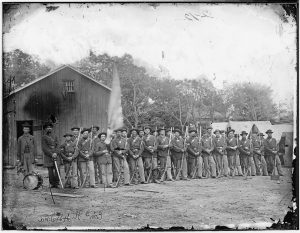On The March: The 44th Indiana 1862-63
One of the more oft-overlooked resources are local newspapers, which published letters from the battlefront throughout the war. For small towns where many of the military-age males had signed up, such letters were of community interest.
One such town was Lagrange, Indiana, the county seat of Lagrange County. The county provided complete companies to the 30th, 44th, and 100th Indiana Volunteers, along with other members of other Hoosier State units. Several correspondents from the 44th’s Company H wrote home to Lagrange, and the local newspaper published their letters.

The letters contain interesting tidbits of the war through the eyes of northeastern Indianans as they served in Tennessee, Mississippi, Alabama, Kentucky, and north Georgia. Some of those observations are as follows:
Hiram King on encountering a slave auction in Kentucky: It was a strange pitiful sight, that of women and little children standing upon the auction block to be sold as human chattles. They came wringing their hands and with tears and sobs, lamenting their cruel fate . . . They regarded the coming of the soldiers as the precursor of their liberty.
W.D. Groves describes the march from Shiloh to Corinth: We started about noon, but after traveling about two miles the road became so blocked with teams, artillery, &c., which were stopped on account of the teams in advance being stuck in the mud, and we, not being able to pass with our baggage wagons, camped for the night. The next day we marched about five miles . . .
M.B. Butler about the regiment’s foraging in Kentucky and Tennessee: The boys in our regiment had wonderful endurance. They could march all day and at night canvass the country for two miles around the camp . . . The third day after leaving the mountains, every man was carrying one or two chickens and occasionally a nice turkey. [General] Buell’s orderly rode along from the rear to the front and as the passed us, the poultry, then a little noisy, attracted his attention. He took out his pass book and asked the company and regiment. [Captain] Nelson responded, “Company G, 13th Kentucky.”
J. Opie in Middle Tennessee after the Tullahoma Campaign: The village near where we are camped has seen better days. Thrift and enterprise, though, are now among the things that were . . . The surrounding country has a rather romantic appearance, being somewhat bordering on the mountains, and as a matter of course is very healthy.
An anonymous writer reflects on recent events: We have just been given the joyous news as I am sure that you have heard, of the great fall of Vicksburg, that bastion of the rebels that for so long has blocked the Mississippi River and hindered our movement on that river and the great victory and routing of Lee at Gettysburg in Pennsylvania. Lee has forever been victorious over the Potomac Army and now, to our great joy the “Potomac Dandies” have finally shouldered their share of the load and driven “Ole Marse Robert” back to his viper’s den in Virginia.
These are drawn from Robert Willey’s The Iron 44th, available in paperback and as an e-book.

Thanks for posting this interesting article. How did the 44th get the moniker Iron 44th? Also, the picture shows the men not wearing kepis, looks like the iron brigade.
The name comes from the Battle of Shiloh, where a Wisconsin soldier said the regiment “fought like iron men – they wouldn’t run.”
& is this the same regiment that also fought @ Fort Donelson, Siege Of Corinth, Battle Of Perryville,
Stones River, Chickamauga & Missionary Ridge, thanks
Yes it is. There’s some good information available online about the regiment and its service.
I also find the ads that accompanied the soldier letters very revealing. The most impactful come from the Nashville Daily Union Banner (LOC) during Hood’s Nashville Campaign. Even as Hood’s men were shivering in their open trenches they could hear the calliope playing for an elaborate circus performance three time a day. An ice cream parlor held its grand opening. Slaves were auctioned on the courthouse steps by the sheriff to settle debts. Elaborate multi course meals featuring shell fish & salmon were on the menus. I know of no more graphic way to depict the relative states of the opposing armies.